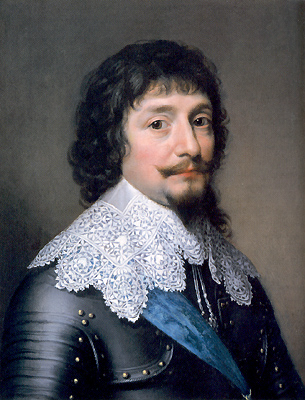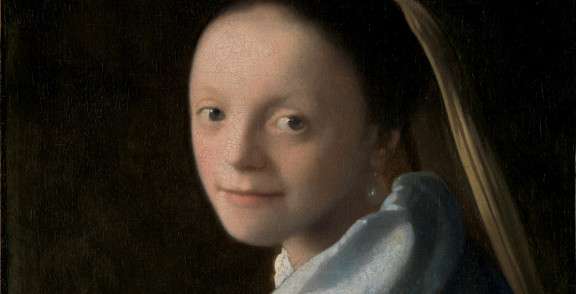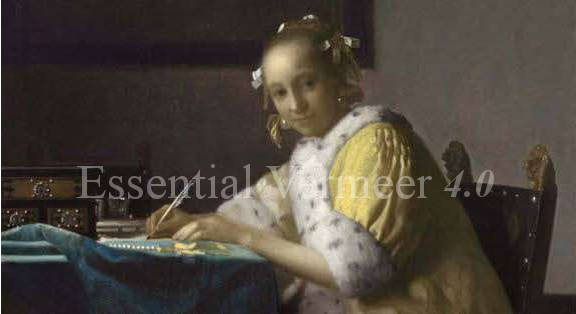Fredrick V, Elector of the Paltinate
Michiel Janz. van Miereveldc. 1628–1632
27 x 29.5 cm.
Kunsthandel Hoogsteder & Hoogsteder, The Hague

Michiel Janz. van MIEREVELD
Delft 1567–1641 Delft
Michiel Jansz van Miereveld was one of the most celebrated portrait painters of his day. His reputation was based principally on his skill in achieving a perfect likeness. Moreover, he surpassed many of his contemporaries in the three-dimensional quality of his faces, the splendid detail of the clothes and the pleasant play of light.
From 1604, Miereveld regularly took on commissions for paintings at the stadholder court in The Hague. One of his first subjects in this circle was Louise de Coligny, widow of William of Orange. Prince Maurice, who hated posing, gave the artist just one opportunity in 1607 to paint 'from life'. All subsequent portraits of the Prince are based on the sketches made on that occasion, with Miereveld adapting the appearance and hairstyle to the subject's actual age.
Miereveld's first portrait of Frederick Henry (1584–1647), youngest son of William of Orange, and brother and successor of Prince Maurice, dates from around 1610. Until about 1637, Miereveld's studio remained suppliers to the court of state portraits. Later, Gerard van Honthorst and his colleagues took over the position.
This portrait of Frederick Henry is a version of the painting that Miereveld created in 1632 of the Prince. The very first of these was probably commissioned by the States of Holland or the municipality of The Hague. Similar three-quarter length portraits are kept at the Upper Chamber of the States General and at the Hague Historical Museum (from the town hall of The Hague).
This painting is a bust of the Prince wearing the order of the Garter. With his robust, blushing face, he turns towards us with serious but lively eyes. It shows why Miereveld was such a celebrated artist. The head in the portrait is nicely composed and beautifully executed. The hair of the moustache, beard and eyebrows is almost tangibly detached from the skin. While the effect of the shadow is to separate the Stadholder's face from the background. Special attention has been paid to the detail of the fashionable lace collar and the costly items of dress armor, with its copper inlay decoration. The use of colour is subtle: the grays of the armor and hair unite the figure, while the ribbon of the Garter provides an attractive colour highlight.
One modern detail in the painting is the oval stone cartouche with scroll decoration that surrounds the depiction of the Prince. This motif, found originally in prints, has a twofold purpose: it gives the composition depth and it literally creates a framework for the portrait. Gerard van Honthorst turned this kind of oval frame into a highly popular feature in Dutch portraiture. Even Rembrandt used it, as in his portrait of Amalia van Solms of 1632, currently in Musée Jacquemart-Andrée in Paris.
- Willem van Aelst (2)
- Balthasar van der Ast (6)
- Hendrick Avercamp (3)
- Dirck van Baburen (7)
- Jacob Adriaenz. Backer (3)
- David Bailly
- Ludolf Bakhuysen
- Bartholomeus van Bassen
- Cornelis Bega
- Gerrit Berckheyde (2)
- Gillis Gillisz de Bergh
- Jan van Bijlert (7)
- Jan de Bisschop (2)
- Abraham Bloemaert (4)
- Pieter De Bloot
- Ferdinand Bol (3)
- Hans Bollinger
- Paulus Bor (2)
- Ambrosio Bosschaert (7)
- Jan Both
- Leonaert Bramer (4)
- Salomon de Bray (2)
- Quiringh van Brekelenkam (4)
- Jan Gerritszoon van Bronchorst (2)
- Adriaen Brouwer (5)
- Hendrick ter Brugghen (6)
- Hendrick van der Burch (5)
- Willem Buytewech (6)
- Abraham van Calraet (2)
- Jacob van Campen
- Jan van de Cappelle(3)
- Pieter Claesz (4)
- Pieter Codde (6)
- Adriaen Coorte (9)
- Josse van Craesbeeck (2)
- Aelbert Cuyp (6)
- Philip van Dijk
- Gerrit Dou (10)
- Willem Drost (2)
- Hendrick Dubbels
- Jacob Duck (4)
- Karel Dujardin (3)
- Willem Duyster (5)
- Gerbrand van den Eeckhout
- Pieter Jansens Elinga
- Cesar van Everdingen (5)
- Allaert van Everdingen
- Carel Fabritius (5)
- Goveart Flinck
- Frans Francken the Younger
- Aert de Gelder
- Cornelis Gijsbrechts
- Jan van Goyen (6)
- Frans Hals (3)
- Dirck Hals (5)
- Jan Davidsz. Heem (6)
- Maerten van Heemskerck
- Bartholomeus van der Helst (4)
- Jan van der Heyden (8)
- Meyndert Hobbema (3)
- Gerard van Honthorst (8)
- Pieter de Hooch (12)
- Van Hoogstraten (9)
- Gerard Houckgeest (4)
- Jan van Huysum (3)
- Willem Kalf (4)
- Jan van Kessel
- Philip Koninck (2)
- Gérard de Lairesse (5)
- Pieter Lastman
- Judith Jansdochter Leyster (5)
- Jan Lievens (4)
- Jacob van Loo (7)
- Nicolaes Maes (9)
- Cornelis de Man (5)
- Gabriel Metsu (12)
- Michiel Janz. van Mierevelt (3)
- Frans van Mieris (8)
- Jan Miense Molenaer (5)
- Pieter Molijn (2)
- Paulus Moreelse (2)
- Pieter Mulier
- Michiel van Musscher (5)
- Aert van der Neer (3)
- Eglon van der Neer (3)
- Caspar Netscher (5)
- Jacob Ochervelt (8)
- Jacob van Oost (2)
- Adriaen van Ostade (5)
- Antonie Palamedesz (6)
- Adam Pijnacker (5)
- Egbert van der Poel (2)
- Jan Porcellis (4)
- Pieter Symonz. Potter
- Paulus Potter (7)
- Pieter Jansz. Quast (2)
- Rembrandt van Rijn (complete oeuvre)
- Jacob van Ruisdael (8)
- Solomon van Ruisdael (7)
- Rachel Ruysch (2)
- Pieter Saenredam (3)
- Godfried Schalcken (6)
- Hercules Segers (2)
- Hendrick Sorg (4)
- Jan Steen (8)
- Harmen Steenwyck (3)
- Matthias Stom (2)
- Michael Sweerts (6)
- David Teniers the Younger
- Gerrit ter Borch (15)
- Willem van de Velde (7)
- Jacob van Velsen
- Johannes Verkolje (2)
- Jan Cornelisz Verspronck (4)
- Abraham de Verwer
- Simon de Vlieger
- Hendrick van Vliet (2)
- Daniel Vosmaer (4)
- Jacobus Vrel (8)
- Jacob van Walscapelle (2)
- Jan Baptist Weenix (2)
- Jan Wijnants (3)
- Emanuel de Witte (6)
- Philips Wouwermans (2)




 or anything else that isn't working as it should be, I'd love to hear it! Please write me at:
or anything else that isn't working as it should be, I'd love to hear it! Please write me at: